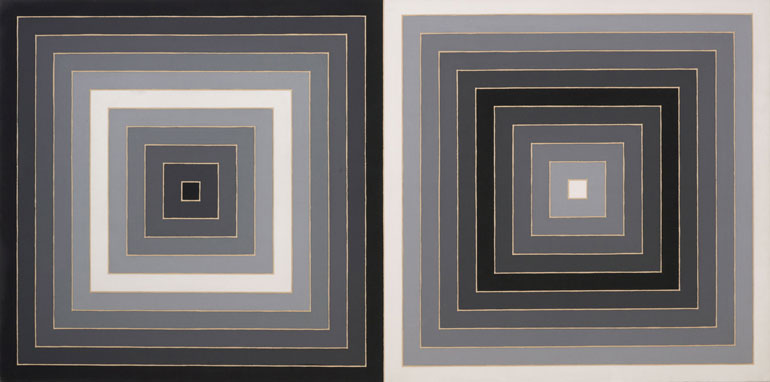 |
| Ai Weiwei The Law of the Journey, 2017 |
I was drawn to the chapter of the Sydney Biennale on
Cockatoo Island by the press pictures of Ai Weiwei’s The Law of the Journey (2017). The installation looked curious and
topical with its references to the refugee crisis, but I couldn’t have
anticipated the power of the work awaiting me. I find Ai Weiwei’s work to be highly
conceptual and therefore, at times, it can leave me cold. But this
wasn’t my experience of The Law of the Journey, also making for a
pleasant surprise.
The 60-meter-long inflatable rubber boat stuffed full with
identical anonymous inflatable figures made in a factory in China that also
makes the vessels for transport of migrants and refugees crossing the
Mediterranean is breathtaking. It is so much more than an intellectual concept.
Approaching the boat from a side room, we are overwhelmed by its sheer size.
The PVC vessel towers above us demanding our attention to the magnitude of the
problem that it represents. As we walk along the sides, it’s as though we are
transported across the seas with the occupants. Some of the figures lean in,
others lean out, others over and still more crouch down as if seeking protection from a giant
wave. The figures are identical—rubber and faceless, clearly fabricated from
the same mold. While they were all male in form, I didn’t get the sense that
the work was gendered, that the refugee crisis is by definition a male crisis,
but rather, the repetition and unidentifiable figures reinforce what the artist says in the publicity material: this is a generic crisis.
 |
| Ai Weiwei The Law of the Journey, 2017 |
As visitors walk around the monumental installation, along
the edges of the platform on which the boat sits, quotations from well-known
writers from different centuries and different parts of the world remind us of
our connection to those who suffer on these journeys. Kafka is quoted: “We are
as forlorn as children lost in the woods. When you stand in front of me and
look at me, what do you know of the griefs that are in me and what do I know of
yours.” And Nawal El Saadawi, “I kept falling like an object thrown into a
limitless sea, without shoes and without a bed, slashed by the waters when it
starts to sink, and by the wind if it starts to float. Forever sinking and
rising between the sea and the sky, with nothing to hold on to except the two
eyes.” Even if we have not been to sea, have not fled war, violence and civil unrest, we all
have the experience of being cast adrift from the familiarity of everyday life.
 |
| Ai Weiwei The Law of the Journey, 2017 |
High on a viewing platform at one end of the installation
we see hundreds of figures in the bottom of the
boat, figures lying down, their heads conjuring images of children
caught in the bottom of the boat. The artificial lighting placed high above on
the ceiling of what was once a shipbuilding workshop gives some figures a copper
colouring. While the transience of the humans in search of another life is
emphasized through the inflatable forms, the copper toning of those in the
light gave them a permanence, like cast bronze statues. From certain angles,
the light givesw the impression of the sun shining on the figures at the end of
the day, the tired bodies rocking with the boat on the waves. The new perspective given by height and illumination was, for me,
an invitation to contemplate the ongoing phenomenon of dangerous sea crossings
by people looking for a better, safer, life.
Another installation that I found particularly compelling was Yukinori
Yanagi’s Landscape with an Eye (2018)
in which a video of a giant eye is suspended in the old power generating room of Cockatoo Island's industrial complex.
Inside the iris, footage of H-Bomb tests invest the eye with a whole new
level of meaning: vision is transformed into desire and destruction for war,
power and coercive manipulation. It was also interesting to note how difficult it was to see the piece because the space was dark and not immediately welcoming. Next door in the Rectifier Room, Absolute Dud (2016), a one-tonne replica of
the atomic bomb dropped on Hiroshima on 6 August 1945 hangs from the ceiling, a
force waiting to explode. The two pieces take on an enormously complex
significance: a Japanese artist is presenting these icons of Western
destruction on an island originally used for convicts. And the story digs
deeper when we see that the two pieces about the misuse of energy and power are
displayed in power supply and conversion rooms, that is, in spaces where energy
is itself transformed. The layers of meaning in these potent works feel as
though the explode all façades, even as they quietly communicate with their
environment.
 |
| Yukinori Yanagi, Absolute Dud (2016) |
Though there was a lot more than these installations to see on Cockatoo Island, I want everyone to catch the ferry to the other side of the Parramatta River and see these two as an imperative.









